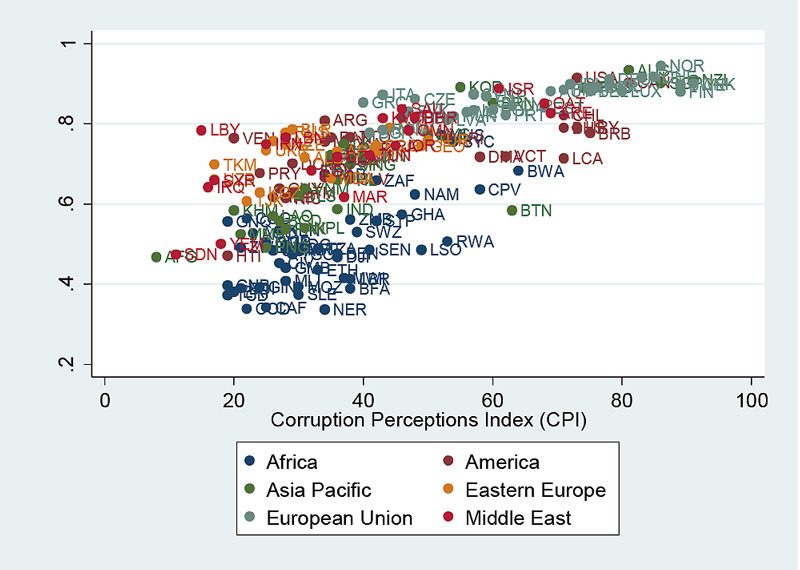SUMMARY
This is AI generated summarization, which may have errors. For context, always refer to the full article.

The media attention to overpriced birthday cakes and parking buildings in Makati, as well as the hacienda in Batangas reportedly owned by Vice President Jejomar Binay have led a number of friends to ask several questions. Some wonder why this information has surfaced only now in media, even if these stories have circulated in coffee shops for quite some time. Others ask why despite these issues, a majority of voters (albeit dwindling) would still vote for Binay for president in 2016. Some speculate if there are actually any real documents pinning him down, or whether he may have assets hidden in mutual funds of foreign banks.
Being a statistician, I asked another set of questions that go beyond these allegations: can we actually measure corruption, and if so, is there any evidence to suggest that corruption does harm to society, to our wealth and to our prospects for development?
In order to measure any concept, from economic activity, to poverty, to corruption, we need to define the concept. There is recognition that defining corruption can be quite challenging since corruption is contextual. Despite this, some institutions such as the World Bank and Transparency International have described corruption as “the abuse of public office for private gain,” thus limiting the focus to the public sector, although corruption may also be present in the private sector.
Corruption comes to the public consciousness through media reporting of investigations or prosecutions. But by its very nature, there is no way to assess absolute levels of corruption with “hard” data. Even the total number of bribes reported, or the number of prosecutions in court cases on corruption, cannot be indicators of corruption levels, as these would only show, respectively, how the media are successful in exposing corruption, and how successful the courts are in prosecuting these cases.
Corruption has its roots beyond our lifetimes, and even beyond our borders. They seem to flourish where there are weak institutions. In Cambodia, a poet by the name of Phirum Ngoy wrote about “buying a title as a district governor, bribing to be a master, wanting to be indulgent by spending government’s money. Cheating and deceiving, getting it under the table, thinking you’re clever, fooling around and putting seals…, ” and while these words were actually written a century ago yet they seem to mirror societies in Cambodia, Philippines and many developing countries today.
Since corruption involves “under the table” negotiations, perceptions of corruption would be the only feasible means of getting data on corruption. Thus, in the global front, Transparency International has been generating yearly since 1995 its Corruption Perceptions Index (CPI), a barometer of corruption of counties in a scale from 0 (highly corrupt) to 100 (very clean).
Some analysts have been critical of these attempts to measure corruption because changes in perception data may not reflect reality. One can certainly “create” a story of corruption, and make everyone believe it. One can also mount a successful media campaign suggesting that the extent of corruption has gone down, without really changing what’s happening on the ground. In addition, it is doubtful whether international measures of corruption (such as the CPI) or even governance (such as the World Bank’s Worldwide Governance Indicators) can fully measure what they aim to measure. Such indices may be based on Western standards, whereas governance and corruption have a socio-cultural context, and is better understood and better measured by taking into account the norms of a particular society.
Despite its limitations, the 2013 corruption measure of Transparency International appears to be strongly correlated with a 2013 human development index (HDI), a composite measure of development based on life expectancy, education and income that the United Nations Development Programme (UNDP) produces. The graph also shows that geography matters: development and corruption appear to be geographically linked.
European Union countries, that typically have the highest values of HDI are also having the lowest perceived levels of corruption (and thus the highest CPI values), while economies in Africa that tend to be having the least development are also those with the highest perceived corruption levels).

In the Philippines, there is no official measure of corruption. The Social Weather Stations (SWS) has taken the lead in measuring corruption through its Survey of Enterprises on Corruption, and as expected, institutions involved in public works and internal revenue have difficulty getting good marks, while those in the social sector generally get good or very good ratings.
The now defunct National Statistical Coordination Board (NSCB), which was merged with other statistical agencies into the Philippine Statistics Authority (PSA), generated a good governance index (GGI) in 2004 that serves to track the efficiency of the local government units (LGUs) in their service delivery. This GGI of the PSA-NSCB has its own limitations as it covers 27 available indicators in terms of three types of governance, such as economic governance, political governance and administrative governance
The motion chart below of the GGI (from 2004 up to recent 2011 data) illustrates that when the GGI is examined at regional levels, it correlates quite well with the gross regional domestic product, our measure of economic performance in the regions.
Source: PSA-NSCB
Deserving something better
The Philippines takes governance seriously by examining the WGI in the Philippine Development Plan Results Matrix. The StatDev website of the PSA-NSCB suggests that we are doing well in one of six WGI indicators (political stability), fair in two indicators (control of corruption, and government effectiveness), but poorly in three indicators (rule of law, regulatory quality, as well as voice and accountability).
There are those who suggest that since politicians are often tainted with corruption, we might as well select someone who will get things done. The visualizations of statistics on corruption and governance, however, tell us a story: corruption harms development and prosperity.
If we elect corrupt people into office and wonder why our country is not prospering as it should, then we have no one else to blame but ourselves.
Jose Rizal once wrote that “there are no tyrants, where there are no slaves,” and certainly, there are no corrupt politicians, where there are no voters who put them into power. Why settle? Don’t we deserve any better? – Rappler.com
Dr. Jose Ramon “Toots” Albert is a professional statistician who has written on poverty measurement, education statistics, agricultural statistics, climate change, macro prudential monitoring, survey design, data mining, and statistical analysis of missing data. He is a Senior Research Fellow of the government’s think tank Philippine Institute for Development Studies, and the president of the country’s professional society of data producers, users and analysts, the Philippine Statistical Association, Inc. for 2014-2015. He finished a PhD in Statistics from the State University of New York at Stony Brook. He is also an elected member of the International Statistical Institute, and of the National Research Council of the Philippines, as well as a Fellow of the Social Weather Stations. From 2012-2014, he served as Secretary General of the now defunct National Statistical Coordination Board and in this position, he explained what statistics mean through his bi-weekly blogs at the NSCB.
Add a comment
How does this make you feel?
There are no comments yet. Add your comment to start the conversation.